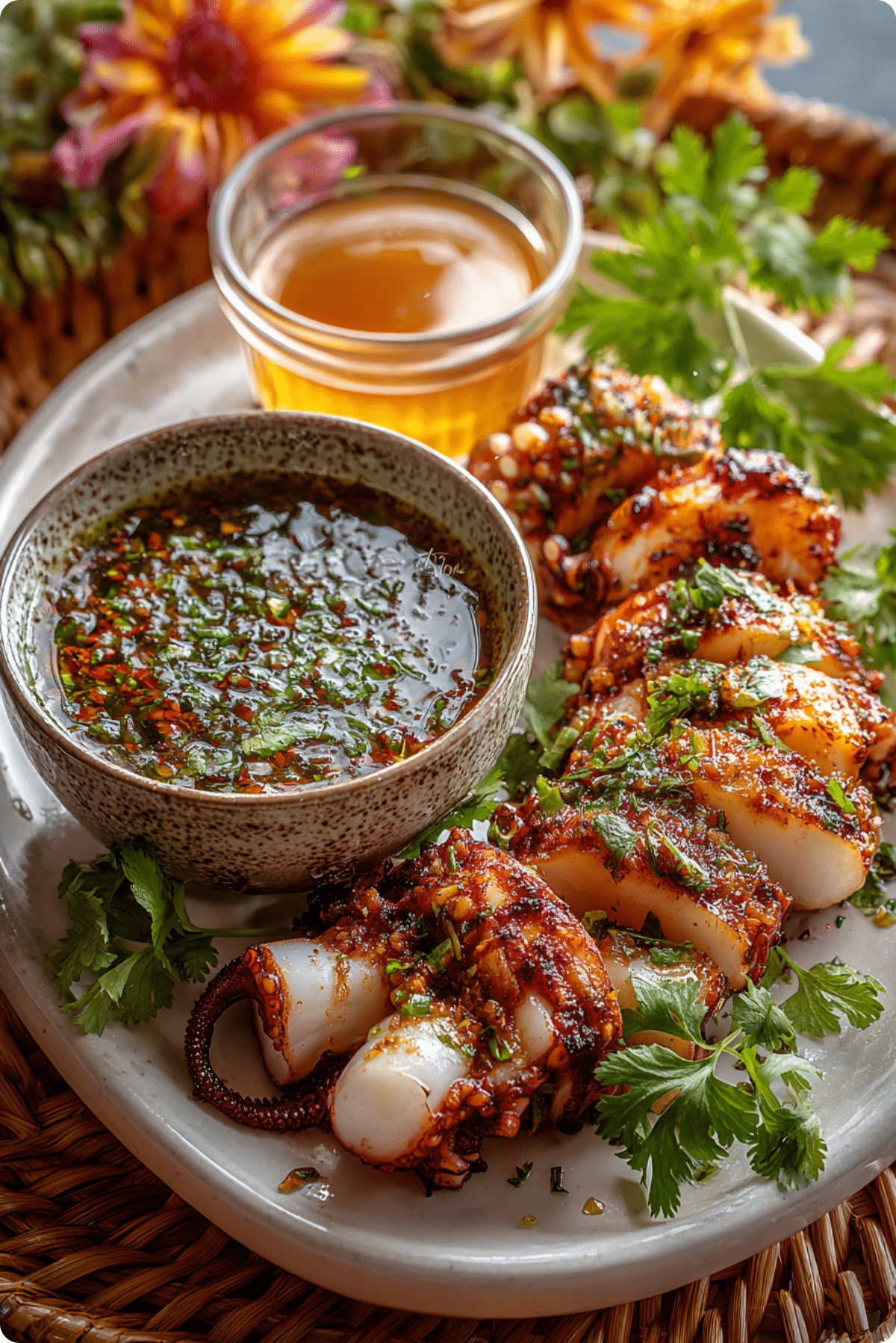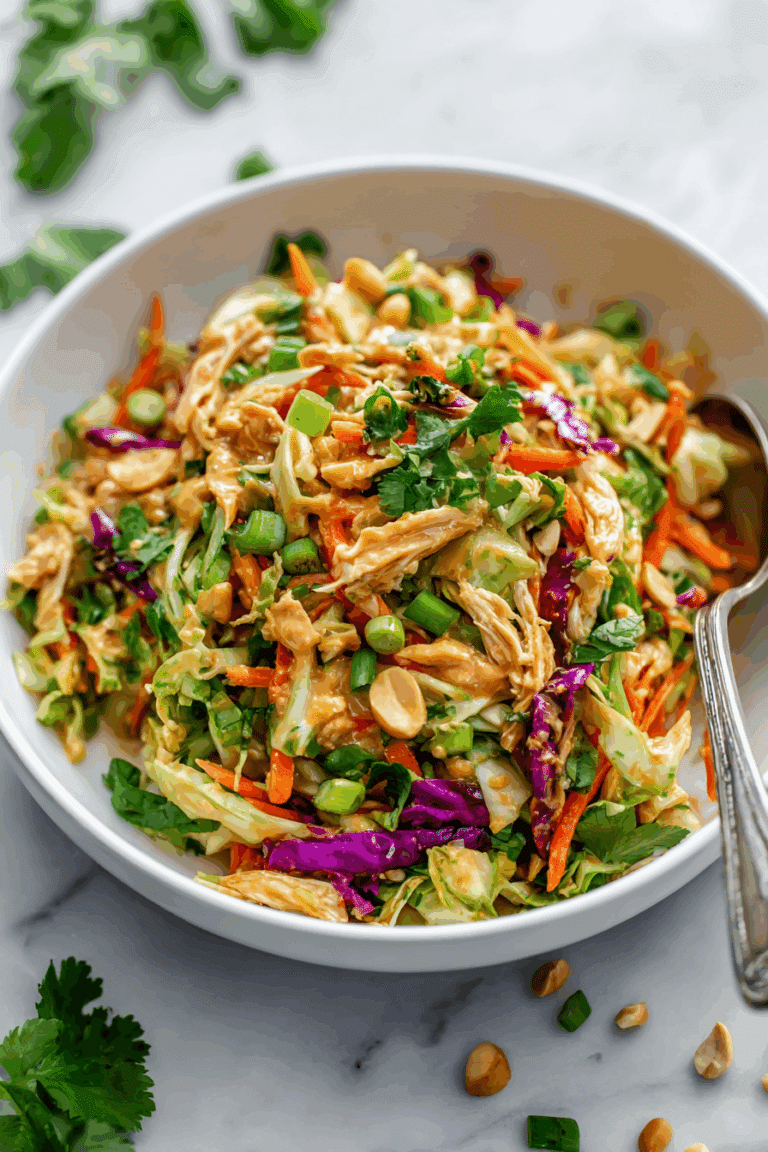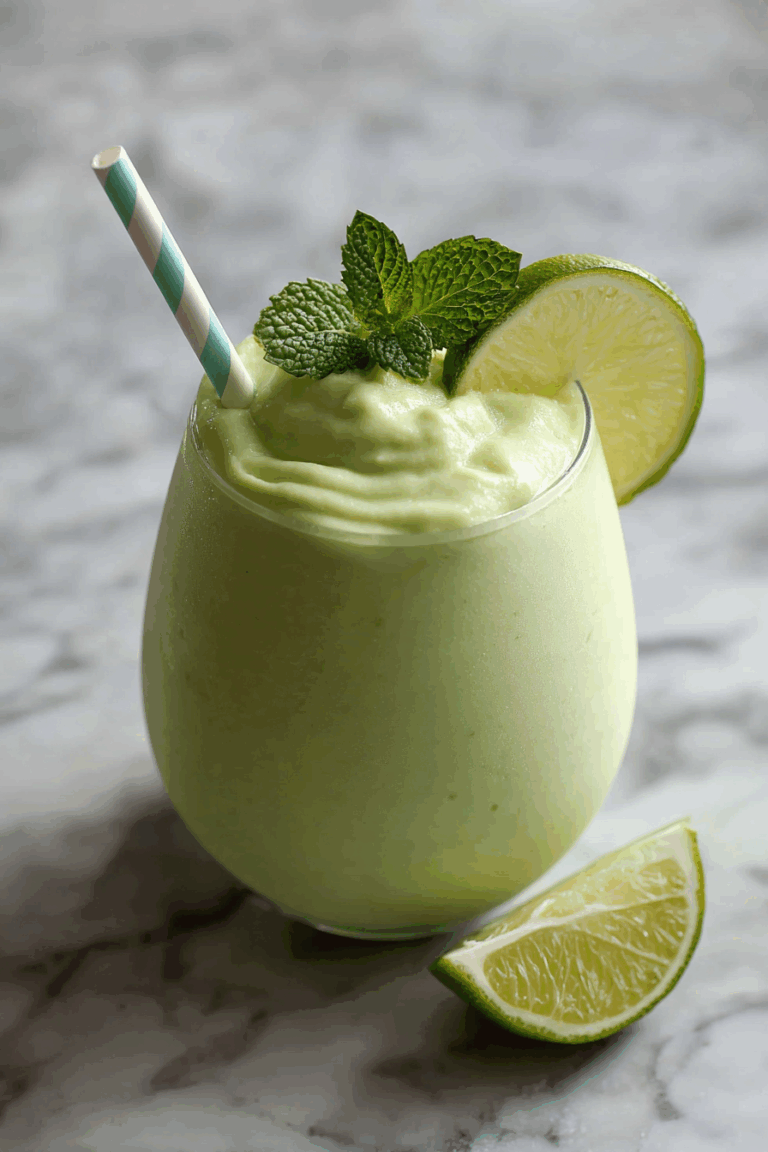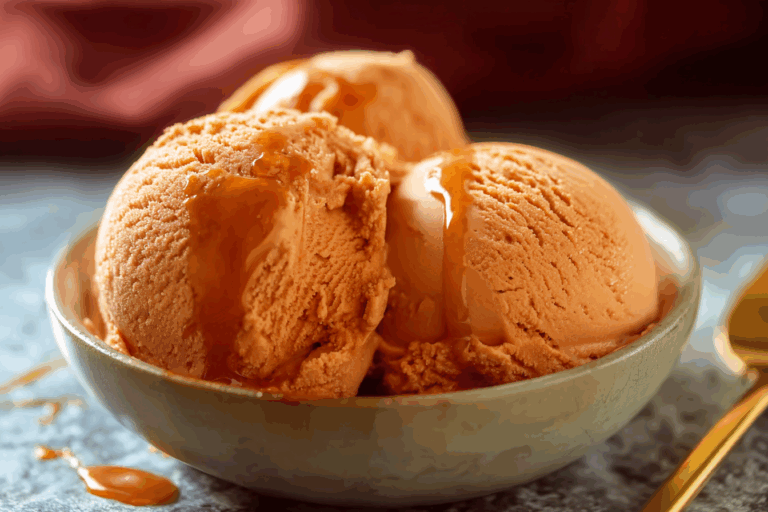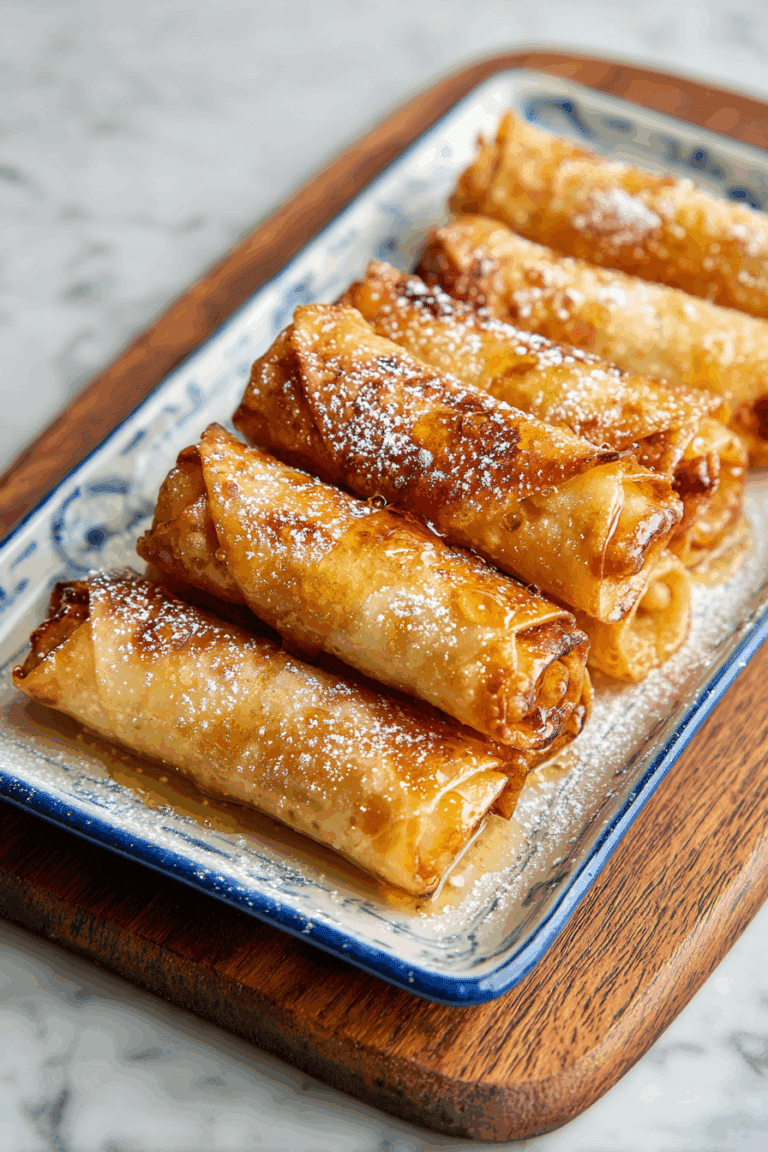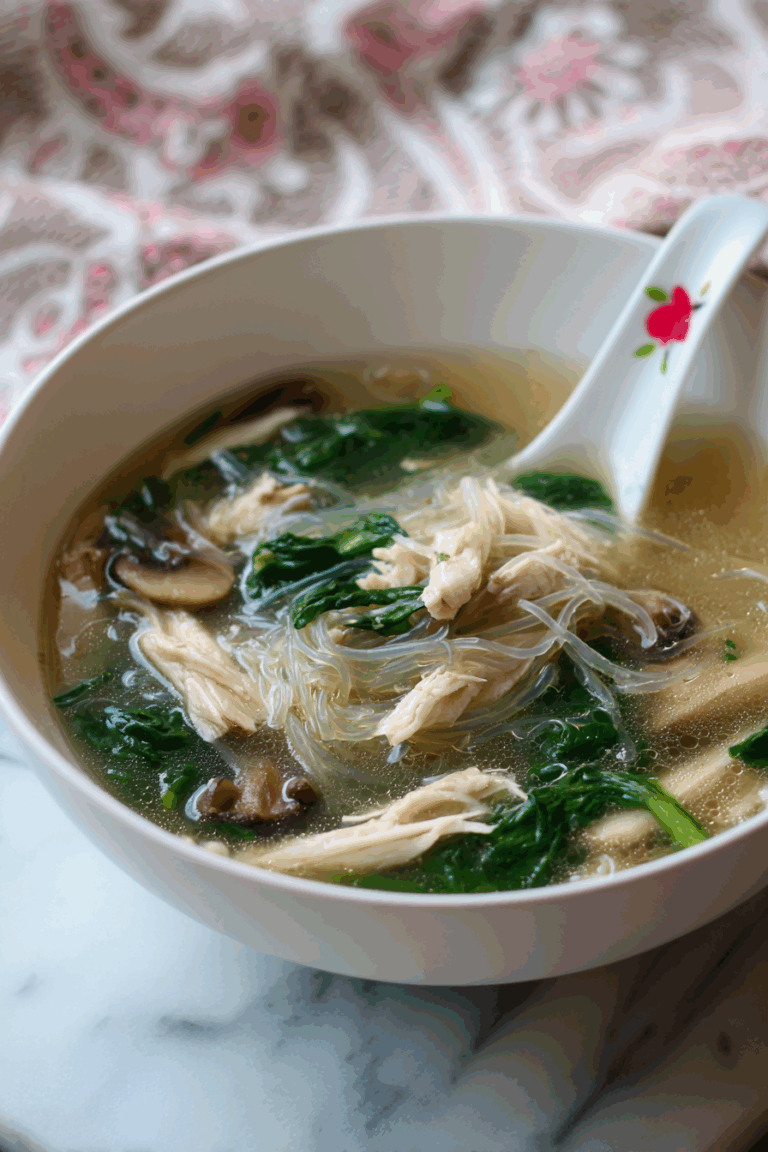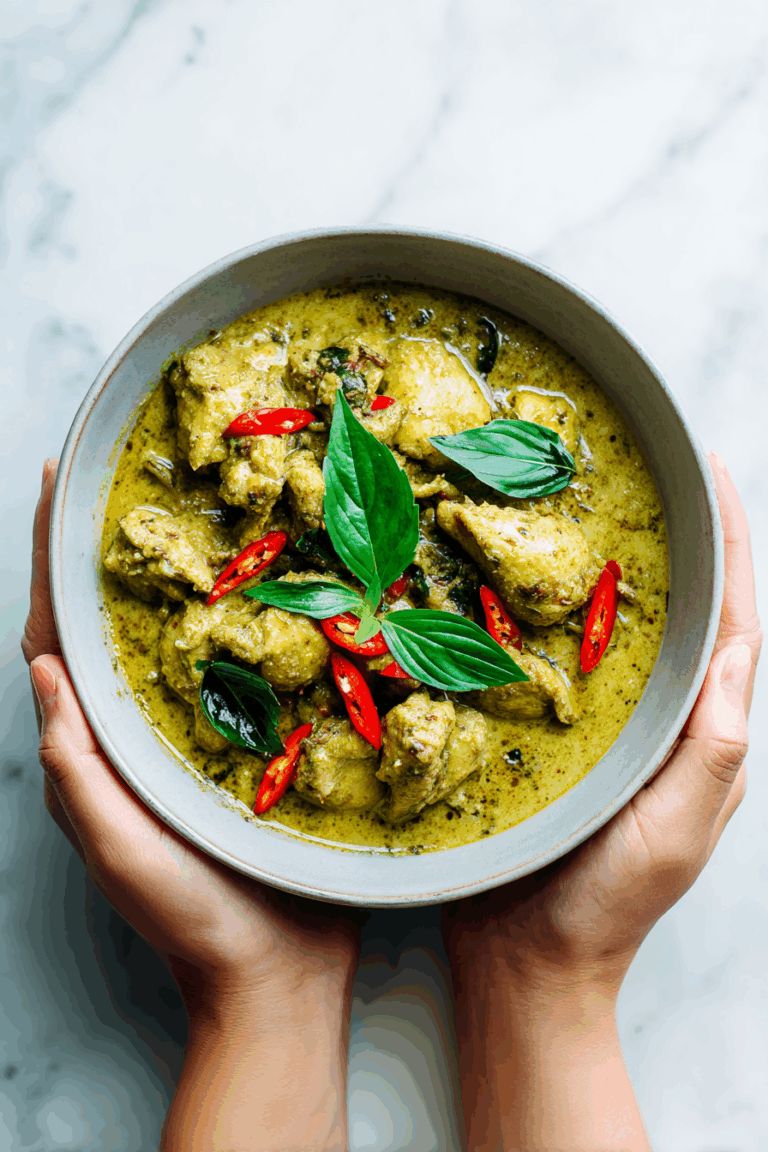Thai Seafood Dipping Sauce: The Best Recipe Ever
Thai Seafood Dipping Sauce is one of those recipes that lives in my heart, and honestly, kind of runs my kitchen. If you love bold and punchy flavor, that perfect mix of spicy, sour, salty, and a tiny touch of sweetness, then Thai Seafood Dipping Sauce is about to become the sauce you will want with every shrimp, every grilled fish, and every crispy fried calamari you ever eat again. A lot of people find this sauce at a Thai restaurant and think it is some secret chef thing that takes years to learn.
The funny truth is, Thai Seafood Dipping Sauce is actually very simple, and very fast, and completely customizable to your taste. Today I am going to show you exactly how to make it the way it is made in Thai home kitchens. You will also learn how to adjust it the same way Thai cooks do, which is more by taste than by measurements.
Before we dive in, I want to tell you a little about us, because every recipe on this site is personal. Our About page story is really the heart of why we cook the way we do. We started cooking Thai food at home because we were homesick for real flavor, not the watered down kind, and Thai Seafood Dipping Sauce was one of the first things we learned to make from family.
It was served in little bowls next to grilled prawns during weekends, and it was always made fresh, never store bought, because Thai Seafood Dipping Sauce is meant to taste alive. Citrus bright. Chili hot. Garlic raw and honest.
We built this site to help you bring that same real taste to your table at home, even if you are cooking in a small apartment kitchen and not in Bangkok by the water. So when I teach you this sauce, I am not just giving you a Thai Seafood Dipping Sauce recipe. I am sharing the story and flavor of a dish that shows up at every seafood meal, every backyard grill night, and every celebration.
By the end of this guide you will understand exactly what goes into an authentic Thai Seafood Dipping Sauce, why each part matters, and how to create your own perfect balance. You will learn about palm sugar versus white sugar, fresh lime versus bottled, and why fish sauce is not optional.
You will also get two methods, the classic mortar and pestle method for that rustic texture, and the food processor shortcut for busy nights. We will go deep on Thai Seafood Dipping Sauce ingredients, and also talk about variations like Thai green seafood sauce recipe style, sometimes called Nam Jim seafood sauce or Thai seafood sauce green.
We will even talk about how to make it a little more mellow if you have friends who cannot handle the traditional Thai heat. I will also answer the most common questions, because you are not the only one who has ever wondered if Thai Seafood Dipping Sauce can be stored, or frozen, or if you can just buy a Thai seafood sauce bottle instead of making it yourself.
Let’s get started, because once you make your first batch of Thai Seafood Dipping Sauce, you are going to start steaming shrimp just to have an excuse to eat more of it.
Table of Contents
Table of Contents
Ingredients
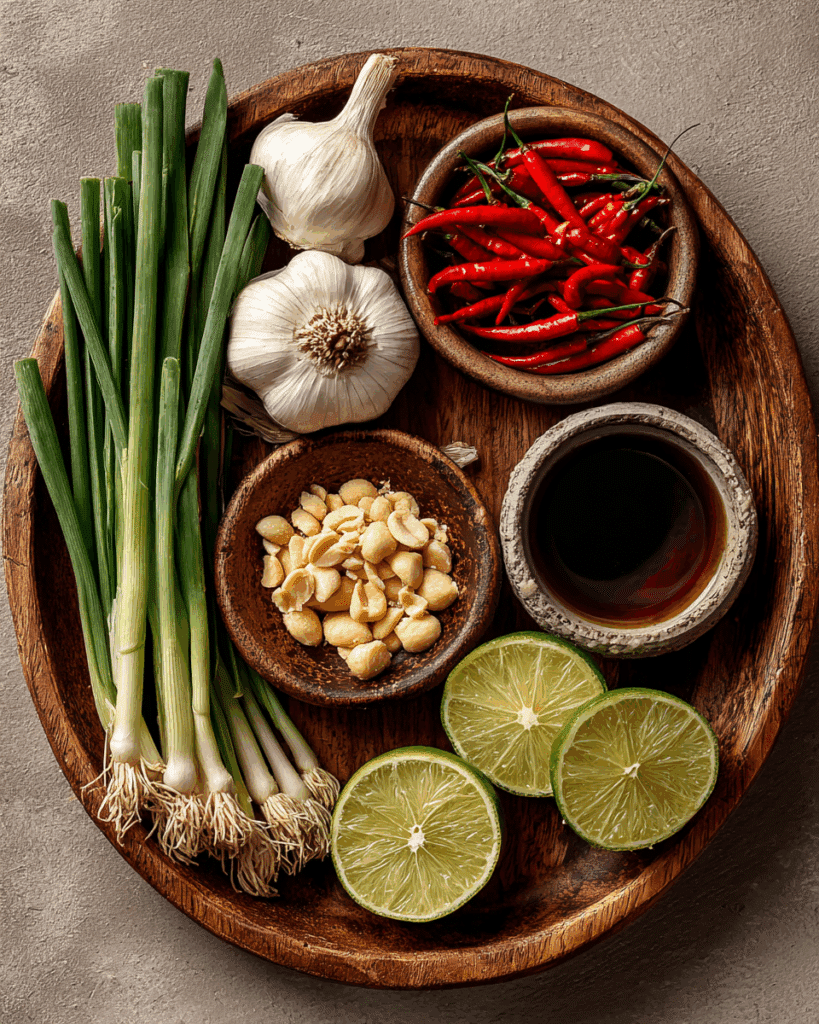
Let us look closely at what you actually need to make Thai Seafood Dipping Sauce at home. The ingredients are humble, which I love, and each one has a job. When you understand what each part does, you will know how to make this sauce taste exactly how you like it, which is how Thai cooks do it. There is no such thing as one fixed version of Thai Seafood Dipping Sauce. You taste, and you adjust. That is the secret.
Here is what you need for one small bowl of Thai Seafood Dipping Sauce, which usually serves two to four people if you are dipping seafood like shrimp or crab legs.
2 cloves garlic, peeled
4 red chilies, or more or less depending on your heat tolerance
1/4 cup roasted peanuts
2 and 1/2 tablespoons palm sugar
2 tablespoons fish sauce
Juice of 1/2 lime
Now let us talk about each one and why it matters in real Thai Seafood Dipping Sauce, because this part really decides if your sauce ends up balanced or not.
Garlic
Raw garlic is one of the loudest flavors in Thai Seafood Dipping Sauce. It gives that sharp, punchy, almost spicy smell that hits you before you even taste it. You want fresh peeled garlic cloves, not garlic powder. Garlic powder will not give you that same alive taste.
When you pound fresh garlic in a mortar and pestle, the oils break out and make the sauce deep and savory and a little aggressive, which is exactly what you want in a Thai Seafood Dipping Sauce that is meant to be eaten with clean tasting seafood. If your garlic cloves are huge, you can use one and a half instead of two. If you love garlic, use three. That is how personal this sauce is.
Red chilies
This is where the fire lives. Traditional Thai seafood dipping sauce usually uses Thai bird’s eye chilies, which are tiny and very hot. If you can handle it, use them. If you cannot, you can mix them with a milder red chili like Fresno or even red jalapeño. The color is important too. Red chilies keep your Thai Seafood Dipping Sauce a warm orange or red tone, while green chilies will give you that Thai seafood sauce green color that you see in Thai green seafood sauce recipe versions.
So if you are chasing that classic Nam Jim seafood sauce style that looks bright green and almost glowing, you can swap the red chilies for green bird’s eye chilies and maybe a touch of cilantro stems. For a more classic red or amber sauce, stick with red chilies. You can also remove seeds to lower the heat, but to be honest, most Thai cooks leave them in.
Roasted peanuts
Now this one surprises some people. Roasted peanuts add body and texture. They thicken the sauce just a bit, and they give the dipping sauce a warm nutty background that balances all the acid and salt. When you crush roasted peanuts into the paste, especially with a mortar and pestle, they also help pull everything together into something that can cling to shrimp or squid. You want unsalted roasted peanuts for your Thai Seafood Dipping Sauce.
Salted peanuts can make it too salty once you add fish sauce. Peanuts are also the reason the sauce does not feel watery. I think peanuts are honestly a quiet hero in this Thai Seafood Dipping Sauce recipe.
Palm sugar
Palm sugar gives gentle sweetness. It is not sharp like white sugar. It is more mellow, almost caramel-like, and it rounds out the heat from the chilies and the acidity from the lime. Traditional Thai seafood dipping sauce almost always uses palm sugar, and if you want something close to authentic Thai seafood dipping sauce, use palm sugar if you can. You can usually find palm sugar in round discs.
Just shave or chop off what you need. If you truly cannot get palm sugar, you can use light brown sugar or even honey, but the flavor will not be exactly the same. Palm sugar is part of what makes people say wow when they taste Thai Seafood Dipping Sauce for the first time, because it makes spicy feel more friendly.
Fish sauce
This is the salt in Thai Seafood Dipping Sauce, and it is also the umami. Fish sauce is fermented fish extract, salty and deep and oceanic. If you smell it straight from the bottle, it might feel strong, but once it is mixed into the sauce with lime and chili and garlic, it just becomes this savory base layer that tastes like seafood wants to taste. You cannot replace fish sauce with soy sauce and still call it Thai Seafood Dipping Sauce.
If you need a fish free version for someone who does not eat fish sauce, you can use a vegan fish sauce alternative, usually made from fermented seaweed and mushrooms, but that becomes more of a chili lime dip and less of a true Nam Jim seafood sauce.
Lime juice
Fresh lime juice is the acid that wakes everything up. Lime is what makes Thai Seafood Dipping Sauce taste bright and clean and alive enough to stand up to fatty seafood like salmon belly or sweet buttery crab. Do not use bottled lime. I know it is tempting. But bottled lime almost always tastes dull, or bitter, or cooked. You want that just squeezed citrus so the Thai Seafood Dipping Sauce feels vivid and fresh. Lime also decides the final salt balance, because the more lime you add, the more fish sauce and palm sugar you may want to add to keep everything in harmony.
Water, optional
Sometimes Thai Seafood Dipping Sauce can be a little too intense if you are new to it. You can add a tiny splash of warm water to loosen it and calm the flavor. This is not embarrassing. Lots of home cooks do this, especially when making Thai Seafood Dipping Sauce for a mixed crowd.
So that is your base. Garlic, red chili, roasted peanut, palm sugar, fish sauce, lime. These are the core Thai Seafood Dipping Sauce ingredients. Once you know how each one behaves, you can make classic red Nam Jim seafood sauce, or you can make Thai seafood sauce green style, or you can make a smoother dip for someone who likes a mild seafood sauce they can spoon like salsa. Keep this list nearby, because in the next section we are going into techniques, and that is where everything comes together.
Step by Step Instructions
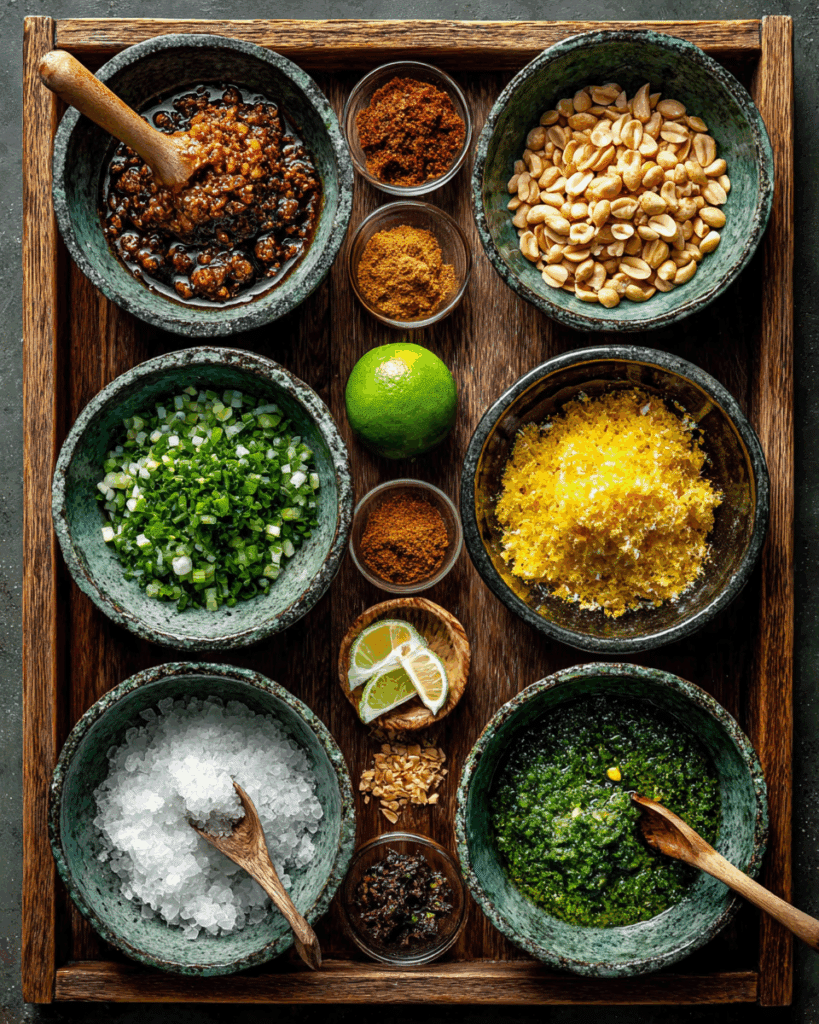
Now let us walk through how to actually make Thai Seafood Dipping Sauce. I am going to show you two methods. The traditional mortar and pestle method, and the food processor method. The flavor is very close in both. The texture will change a little, so pick the one that fits your style and your kitchen.
Method 1. Mortar and pestle method
Step 1. Pound the garlic and chilies
Add the peeled garlic cloves and your red chilies to the mortar. Start pounding and grinding in a circular motion. The goal here is to break down the garlic into a fine paste and release the chili heat into it. Take your time. You are not just smashing. You are creating aroma. You want a paste, not big chunks. This first step sets the base of your Thai Seafood Dipping Sauce and decides how strong the flavor will bloom later.
Why we start with garlic and chili
When you crush chili and garlic with salt or liquid, some of that flavor just floats in the liquid. When you crush them first, with nothing else, you are forcing all the oils to break out and blend. This is why Thai Seafood Dipping Sauce from a Thai kitchen sometimes tastes louder and richer than a bottled Thai seafood sauce bottle from the store. The pounding builds flavor in a physical way. You can smell it.
Step 2. Add roasted peanuts
Once the garlic and chilies look mostly like a paste, add the roasted peanuts. Use the pestle to crush the peanuts and fold them into that chili garlic mixture. You want the peanuts to be broken down, but not fully smooth. Tiny bits of peanut give texture so your Thai Seafood Dipping Sauce grips onto shrimp or grilled squid. At this point, the paste should look thick, spicy, and a little rustic.
Step 3. Add palm sugar and fish sauce
Now add the palm sugar and fish sauce. Keep working the pestle to mash the palm sugar into the paste until you get something looser, more saucy. At this stage, your Thai Seafood Dipping Sauce will start to look like an actual dipping sauce, not just a chili paste. The palm sugar melts in, the fish sauce blends, and you get that classic salty sweet base.
Step 4. Add fresh lime juice
Squeeze in the juice of half a lime. Stir with a spoon and taste. This is the first time you taste your Thai Seafood Dipping Sauce and make it yours. Do you want more acid, add more lime. Is it too salty, add a touch more palm sugar or a tiny splash of warm water. Too sweet, add one more splash of fish sauce or one more chili. This is the part where Thai cooks lean over the mortar, taste straight from the spoon, adjust, taste again, smile. That moment is how you learn balance. That moment is how you make an authentic Thai Seafood Dipping Sauce that fits your own mouth, not just a printed recipe.
Step 5. Serve
You can serve Thai Seafood Dipping Sauce immediately. It is best fresh because the lime is brightest. Pour it into a small dipping bowl and set it next to steamed shrimp, poached crab, grilled scallops, fried fish cakes, and even raw oysters if you like heat with brine. Thai Seafood Dipping Sauce is also perfect with grilled squid and crab legs, which is how a lot of coastal Thai families eat it.
Method 2. Food processor method
If you are in a hurry, or you do not have a mortar and pestle, do not panic. You can still make a really good Thai Seafood Dipping Sauce. It will be smoother and slightly more blended, almost like a salsa. Here is how.
Step 1. Add ingredients to the food processor
Add the garlic, red chilies, roasted peanuts, palm sugar, and fish sauce to the bowl of a small food processor.
Step 2. Pulse, do not blend nonstop
Pulse the mixture in short bursts. You want a sauce with a little texture, not a totally smooth paste. When you pulse, you control the size of the chili bits and peanut bits. This matters because texture affects how Thai Seafood Dipping Sauce clings to seafood.
Step 3. Add lime at the end
Once the texture looks right, pour the mixture into a bowl, then stir in fresh lime juice. Taste and adjust just like in the traditional version. If it tastes perfect with your shrimp, it is perfect. There is no test more honest than taste.
A small note about resting
Some people like to let the Thai Seafood Dipping Sauce sit for 5 to 10 minutes so the flavors relax together. The lime softens the garlic bite. The sugar dissolves fully. The chilies bloom. This short rest can make the Thai Seafood Dipping Sauce feel more round and less sharp, which can be great if you are serving guests who are not used to Thai heat.
Texture choices
Mortar and pestle Thai Seafood Dipping Sauce will have a more rustic feel and stronger chili aroma. Food processor Thai Seafood Dipping Sauce will be a touch smoother and maybe a little easier for dipping. Both are correct. Both are real. It just depends what you like with your seafood.
This is your base technique for an authentic Thai Seafood Dipping Sauce. In the next parts we are going to get into more advanced stuff you will absolutely want to know, like storage, flavor tricks, what seafood goes best, and how to talk about Thai Seafood Dipping Sauce like you have been making it forever.
Tips and Tricks for the Perfect Thai Seafood Dipping Sauce
Once you’ve learned the basic steps, making Thai Seafood Dipping Sauce becomes more about instinct than measurement. But there are still a few tricks that can help you reach that perfect balance every single time. These are things I’ve learned through trial, error, and a few too-spicy batches that nearly sent everyone running for water.
1. Adjust the spice level the Thai way
Thai cooks taste as they go. When making Thai Seafood Dipping Sauce, always start with fewer chilies than you think you’ll need, then build up. If you accidentally go overboard, you can mellow the sauce with a little palm sugar and lime juice. Some people even blend in a spoon of crushed cucumber to cool it slightly without changing the flavor too much.
2. Use fresh ingredients every time
This sauce lives and dies by freshness. Old lime juice or pre-minced garlic will make your Thai Seafood Dipping Sauce taste flat. Freshly squeezed lime and hand-pounded garlic give that electric brightness that people fall in love with.
3. Don’t skip the peanuts
Many modern recipes leave out peanuts, but trust me, they make a huge difference. Peanuts give Thai Seafood Dipping Sauce texture and a slightly roasted aroma that ties the flavors together. You can roast them yourself at home for an even deeper nutty taste.
4. Store it smartly
If you plan to serve your Thai Seafood Dipping Sauce later, keep it in a glass container, not plastic, because fish sauce can linger in plastic. Cover and refrigerate it. It stays fresh for up to three days, but the lime will start to lose its brightness after 24 hours. Before serving, always give it a quick stir and a taste test.
5. Read and learn from experts
If you want to dive even deeper into the art of authentic Thai sauces, you should definitely check out Hot Thai Kitchen’s take on Thai seafood sauce. Pailin’s version breaks down the flavor structure beautifully and shows how each ingredient interacts. Another great resource is Thai Caliente’s guide to Thai seafood sauce, which has great tips for making the sauce less spicy without losing character. Both are trusted sources for Thai recipes that stay true to their roots.
6. Taste with the seafood you’ll serve
Always dip a piece of the actual seafood you plan to eat into the sauce before finalizing it. Thai Seafood Dipping Sauce can taste different depending on what it’s paired with. Grilled shrimp brings out the lime and garlic, while fried calamari brings out the sweetness.
7. Balance sweetness and salt at the end
Palm sugar and fish sauce can fight for attention if not balanced properly. The right Thai Seafood Dipping Sauce should never taste overly sweet or salty, but instead, make your mouth water for the next bite. When in doubt, squeeze in a few extra drops of lime and taste again.
If you follow these tips, you’ll never have a boring sauce again. You’ll make Thai Seafood Dipping Sauce that people remember, the kind that wakes up your taste buds before the seafood even hits your tongue.
Variations of Thai Seafood Dipping Sauce
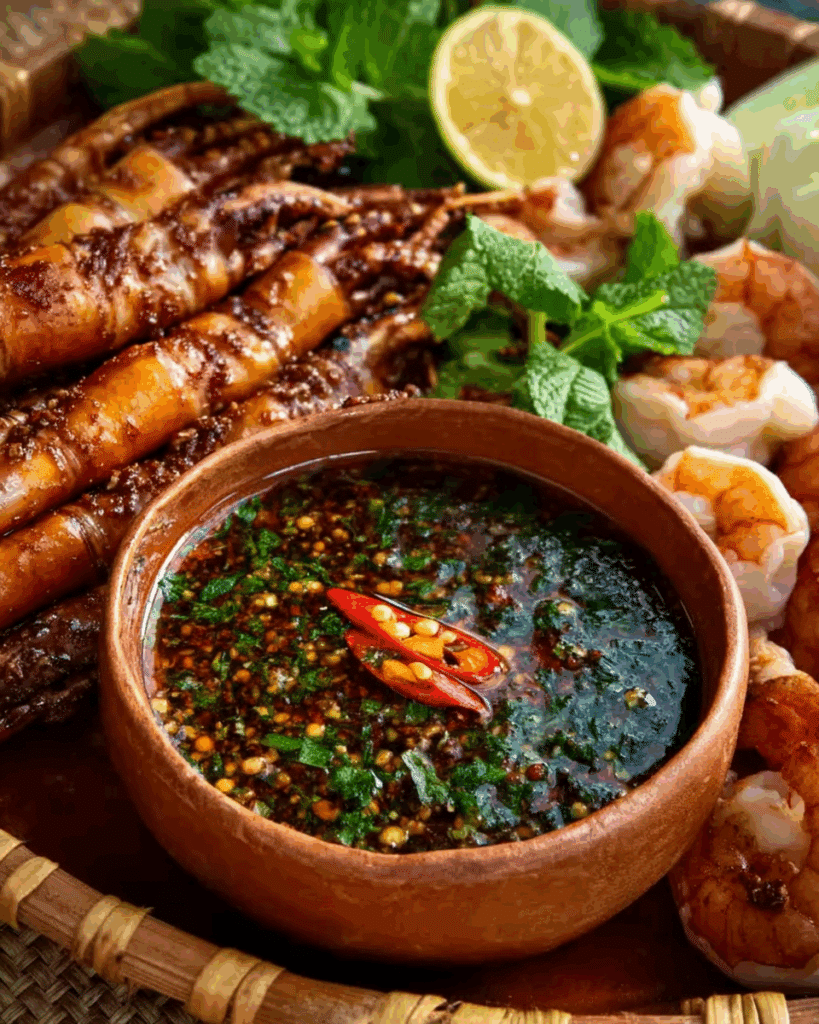
One of the best things about Thai cooking is flexibility. Every region, and even every family, has its own twist on Thai Seafood Dipping Sauce. Here are some creative and traditional variations you can try once you’ve mastered the basic version.
Classic Nam Jim Seafood Sauce
This is the standard dipping sauce you’ll find at seafood restaurants across Thailand. It’s vibrant red-orange and full of chopped garlic, chili, lime, and fish sauce. It’s meant for everything from grilled prawns to steamed crab claws. If you want to keep it authentic, this is your go-to.
Thai Green Seafood Sauce Recipe
This one is sometimes called Thai seafood sauce green, and it gets its color from green chilies, coriander roots, and sometimes even mint. The flavor is brighter and slightly more herbal than the red version. Thai seafood sauce green is especially good with white fish and shellfish because it adds freshness without too much heat.
Sweet and Mild Thai Seafood Dipping Sauce
If you have guests who can’t handle too much spice, you can make a mild version by using long red chilies instead of bird’s eye, and doubling the palm sugar. It will be more like a sweet chili lime dressing, but still recognizable as Thai Seafood Dipping Sauce.
Roasted Garlic and Tamarind Twist
For a smoky, tangy flavor, try adding roasted garlic and a teaspoon of tamarind paste. It deepens the sauce and gives it a darker tone. This variation goes really well with grilled seafood and even roasted meats.
Peanut-Heavy Thai Seafood Dipping Sauce
Some people love a crunchier texture, so they double the peanuts and crush them lightly instead of finely. The result is almost like a spicy peanut salsa that’s great on seafood skewers or even rice bowls.
Vegan Thai Seafood Dipping Sauce
If you’re serving vegetarians, you can replace fish sauce with soy sauce or a vegan fish sauce substitute made from seaweed and mushrooms. It won’t taste exactly the same, but it keeps that chili-lime balance alive.
Thai food culture thrives on creativity, and Thai Seafood Dipping Sauce is no exception. You can adjust colors, textures, and heat to match any meal. Once you start experimenting, you’ll see how each tweak brings a new personality to the sauce.
Nutrition and Health Benefits
Let’s talk about the health side of Thai Seafood Dipping Sauce, because while it tastes indulgent, it’s actually quite light and packed with natural ingredients.
Low in calories, big in flavor
A tablespoon of Thai Seafood Dipping Sauce usually has fewer than 30 calories. Most of those come from peanuts and palm sugar. Since it’s meant to be eaten in small portions, you get maximum flavor for minimal calories.
Packed with antioxidants and vitamins
Garlic is known for its antibacterial and heart-friendly benefits. Chilies bring capsaicin, which boosts metabolism and improves circulation. Lime adds vitamin C, which helps digestion and immunity. Together, they make Thai Seafood Dipping Sauce not just delicious but genuinely good for you.
Naturally gluten-free
Traditional Thai Seafood Dipping Sauce contains no wheat-based ingredients, which makes it perfect for people who avoid gluten. Just make sure the fish sauce you use is gluten-free, because some brands can have additives.
Supports clean eating
If you use natural palm sugar and fresh ingredients, your Thai Seafood Dipping Sauce fits perfectly into clean eating plans. It’s low in fat, sugar-balanced, and full of real food flavor.
Helps control portion sizes
Since the sauce is so powerful, you don’t need much to satisfy your craving. A few spoonfuls can transform plain grilled shrimp or steamed fish into a full meal experience. That’s one reason many Thai meals stay balanced even when they feel decadent.
When you eat Thai Seafood Dipping Sauce, you’re not just adding flavor. You’re giving your body a mix of natural heat, freshness, and balance that makes you feel energized, not heavy. It’s a perfect example of how traditional Thai cooking blends taste with health.
Make Ahead, Storage, and Freezing
Let us be honest. Thai Seafood Dipping Sauce is at its absolute best when it is fresh. You pound the garlic and chili, you squeeze the lime, you taste the fish sauce and palm sugar, and you eat it right away with something juicy and hot off the grill. That is the romantic version.
But real life is busier than that, and sometimes you want to prep ahead, especially if you are planning a seafood night, or a party where everyone is peeling shrimp and dipping nonstop. So let us talk about what you can do in advance, how long Thai Seafood Dipping Sauce lasts, and how to keep the flavor as close to just made as possible.
First, can you make Thai Seafood Dipping Sauce ahead of time. Yes, you can. The base of Thai Seafood Dipping Sauce holds up pretty well in the fridge for a short period. What you want to do is prepare everything except the lime juice. So you pound or blend your garlic, chilies, roasted peanuts, palm sugar, and fish sauce until you get that saucy texture. Then you store that mixture in an airtight glass jar.
Glass is better than plastic, because fish sauce is very strong and it can leave a smell in plastic. When you are ready to serve, you squeeze in the fresh lime juice, stir, taste, and you get something that is extremely close to fresh Thai Seafood Dipping Sauce. Doing it this way protects the brightness of the lime, which is one of the most important parts of Thai Seafood Dipping Sauce.
How long does Thai Seafood Dipping Sauce last in the fridge. If you already mixed in the lime juice, you should try to use it within 2 to 3 days. After that, the citrus starts to go dull, and the peanuts can get a little soft. The sauce is still safe, usually, because of the salt and acid in Thai Seafood Dipping Sauce, but the flavor will not be as clean. If you store only the base mix without the lime, you can actually get 4 to 5 days in the refrigerator. Then you just finish with lime juice when the seafood hits the table.
Let us talk about freezing. People ask this a lot because Thai Seafood Dipping Sauce feels like something you want in your freezer all the time. You technically can freeze Thai Seafood Dipping Sauce, but I do not really recommend it when you care about peak flavor. Freezing changes the texture of the peanuts and the brightness of the lime. When you thaw it, you might notice that Thai Seafood Dipping Sauce tastes a little muted, kind of sleepy.
If you really want to freeze it, the best way is to freeze only the base paste without lime. Press it into a freezer safe container in a thin layer, or spoon it into ice cube trays so you can defrost only what you need. When you are ready to serve, thaw it gently in the fridge, then stir in fresh lime juice until the Thai Seafood Dipping Sauce wakes up again.
Another little trick. If the sauce has been sitting in the fridge for a day and it tastes slightly too salty or too strong, add a pinch more palm sugar and a splash of warm water, then taste again with a piece of shrimp or fish. Thai Seafood Dipping Sauce is not a sauce you judge by itself in a spoon. You always taste it with the seafood you will serve, because cooked shrimp or steamed crab has sweetness that balances the salt and acid in the sauce.
One more thing about serving temperature. Thai Seafood Dipping Sauce should be served cool room temperature, not ice cold. Cold dulls flavor. So if you made your Thai Seafood Dipping Sauce ahead, pull it out of the fridge 15 to 20 minutes before people start eating. That way the chilies bloom again, the garlic opens up again, and the sauce feels alive the way it should. If it thickens in the fridge, give it a stir and squeeze a touch of lime right before serving.
When you treat Thai Seafood Dipping Sauce with this kind of care, you can absolutely make life easier for yourself and still offer something that tastes fresh, bright, spicy, snappy, and totally addictive with crab legs, grilled scallops, or crispy fried fish.
Common Mistakes To Avoid
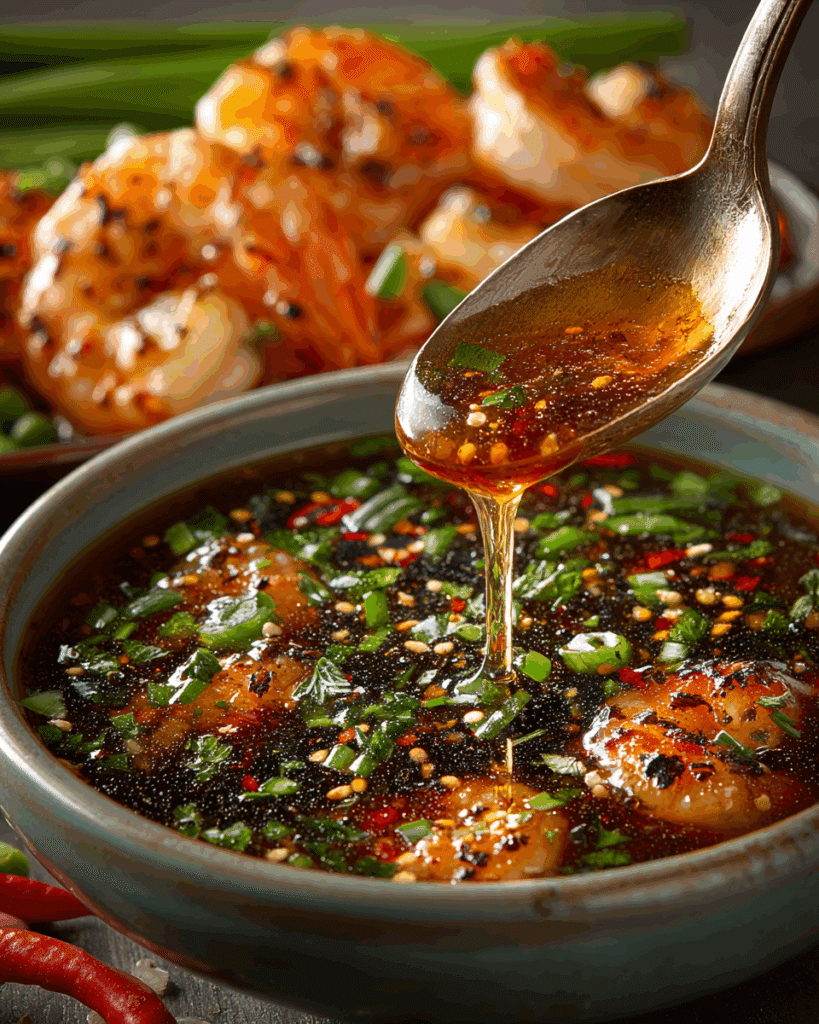
Thai Seafood Dipping Sauce looks simple. A few ingredients, a mortar and pestle, done. But a lot of small mistakes can turn a perfect Thai Seafood Dipping Sauce into a sauce that is unbalanced, or too salty, or kind of bitter. I want to walk you through the most common problems people run into, and how to fix them fast so you do not ruin a whole platter of seafood.
Mistake 1. Using bottled lime juice
This one hurts to say, but it is the number one thing that holds people back. Fresh lime juice is not optional in Thai Seafood Dipping Sauce. Bottled lime juice tastes dull and sometimes bitter, and it just will not give you that clean brightness that makes Thai Seafood Dipping Sauce feel refreshing. The acid in fresh lime also helps balance the deep saltiness of fish sauce. Without it, the sauce can feel harsh. Always squeeze fresh lime right before serving.
Mistake 2. Not tasting as you go
Thai Seafood Dipping Sauce is personal. The recipe is a map, not a law. If you just follow measurements and never taste and adjust, you will probably miss that perfect balance. After you add the lime, you must taste and adjust. Maybe your lime is extra sour. Maybe your fish sauce is saltier than mine.
Maybe your palm sugar is not as sweet. You have to taste and shift. Add a pinch more palm sugar if the heat is punching you too hard. Add another chili if it feels flat. Add a tiny splash of fish sauce if it is too sweet. This tasting step is what makes Thai Seafood Dipping Sauce feel restaurant level.
Mistake 3. Grinding the sauce completely smooth
Some people think they need to blend Thai Seafood Dipping Sauce until it looks like a smoothie. That is not the goal. You want texture. You want tiny crushed peanut bits and little visible chili seeds. Texture helps Thai Seafood Dipping Sauce cling to seafood. It also makes each bite interesting. If you over blend, the sauce can get too pasty and heavy, instead of bright and spoonable.
Mistake 4. Using white sugar instead of palm sugar
Palm sugar has a round, mellow sweetness that kind of hugs the chili heat instead of fighting it. White sugar is sharper and a little artificial tasting in this style of sauce. If you cannot get palm sugar, light brown sugar is a better backup than plain white sugar. A good Thai Seafood Dipping Sauce should never taste like candy. It should taste balanced.
Mistake 5. Skipping the peanuts
I know not every version of Thai Seafood Dipping Sauce uses peanuts, especially in some restaurant styles, and if you have an allergy obviously skip them, but if you can eat peanuts, do not leave them out. Peanuts add thickness and help the sauce hold onto grilled shrimp, squid, or crab.
Without peanuts, your Thai Seafood Dipping Sauce can taste watery and separate at the bottom of the bowl. If you want a smoother sauce, you can pound the peanuts more finely instead of leaving them chunky. The answer is not removing peanuts. It is controlling texture.
Mistake 6. Serving the sauce straight from the fridge
Cold sauce tastes weaker. The garlic feels muted. The chili feels quiet. The lime feels sleepy. Let Thai Seafood Dipping Sauce warm up just a little before you serve it. Stir, taste, and brighten it with a drop of fresh lime. This tiny step can make your sauce taste ten times more alive.
Mistake 7. Forgetting who you are feeding
If you are serving friends who are not used to Thai heat, you might make the Thai Seafood Dipping Sauce the way you love it, then realize at the table that everybody else is crying and reaching for milk. Make a second, milder bowl. Use fewer bird’s eye chilies and more palm sugar. Call it the friendly bowl. This way everyone can enjoy seafood with Thai Seafood Dipping Sauce, without anyone feeling attacked by the spice level. I do this at most gatherings. It always works.
When you avoid these mistakes, your Thai Seafood Dipping Sauce will taste intentional, confident, and balanced. You will notice how people react when they taste it. Eyes go up. Hands pause. Then someone says, wait, what is in this. That is the reaction we are going for.
Cultural and Historical Background
Thai Seafood Dipping Sauce is not just a recipe. It is culture in a bowl. If you sit at a seafood restaurant in Thailand, especially in coastal areas or open air night markets where the seafood is on ice in huge trays, you will always see small bowls lined up around the platters. Those bowls are filled with Thai Seafood Dipping Sauce.
Sometimes it is red. Sometimes it is green. Sometimes it is chunky and rustic. Sometimes it is smoother. But it is always there. You almost never get steamed prawns or grilled squid without it.
In Thai cooking, food is about balance, and also about contrast. Seafood tends to be naturally sweet and delicate, especially things like crab meat, scallops, or fresh steamed fish. Thai Seafood Dipping Sauce is designed to wake that up. The chili brings heat, the lime brings sour brightness, the fish sauce brings salt from the sea, and the palm sugar brings a soft sweetness that ties everything together.
That salty sweet spicy sour balance is one of the core flavor profiles in Thai cuisine. You see it in som tam, which is Thai green papaya salad. You see it in many dipping sauces called nam jim, a word that basically means dipping sauce. And you definitely see it in Thai Seafood Dipping Sauce, which in Thai is often called nam jim seafood.
There is also a social side to this sauce. Thai meals are usually shared. You do not really order one plate for yourself and guard it. You sit with friends or family, and there is a spread in the middle. A whole grilled fish. A plate of steamed prawns. Maybe clams stir fried with basil. And always, at least one bowl of Thai Seafood Dipping Sauce.
Everyone dips from the same bowl, or sometimes there are two different spice levels so everyone can enjoy. The sauce is part of the rhythm of eating. A bite of seafood, a dip into sauce, a little rice, laughter, more seafood, more sauce. It keeps the meal lively. It encourages you to slow down and taste.
There are also regional styles. In some parts of Thailand, especially central regions, Thai Seafood Dipping Sauce leans sour and spicy. Think lots of lime and lots of chili. In the south, where seafood is incredibly fresh and the ocean flavors are strong, the sauce can be a little sweeter and sometimes more garlicky, because it is paired with very briny shellfish.
Some families add cilantro roots or stems, which gives a more herbal, green fragrance. This is where you get that Thai seafood sauce green style. In tourist areas you might notice a version that is slightly sweeter and less spicy, because restaurants adjust for foreign visitors. That is still Thai Seafood Dipping Sauce, just tailored to the table.
Another thing people do not always realize is how proud Thai cooks are of their personal sauce. Everyone has an opinion on what makes the best Thai Seafood Dipping Sauce. Some people swear it should burn. Some people say balance matters more than heat. Some say it should be more sour. Some say the palm sugar should be very present.
You will even find people who insist that their grandmother used to make Thai Seafood Dipping Sauce with a hint of tamarind for extra tang. None of these people are wrong. That is how traditional food lives. It is alive, and it grows with the people who make it.
When you make this sauce at home, you are not just copying a restaurant taste. You are actually cooking something that is eaten in Thai homes, during family style meals, with hands pulling crab claws and peeling shrimp shells while talking about the day. You are bringing that to your table. This is why Thai Seafood Dipping Sauce feels special. It is not just spicy seafood dip. It is part of a way of eating that is generous, communal, and full of personality.
Serving Suggestions
Thai Seafood Dipping Sauce is one of those sauces that seems to make almost everything taste better. You can pair it with traditional Thai seafood dishes, or you can use it as your secret flavor weapon for other meals. Let us look at how to serve it the way Thai families do, and also how to bring it into your own kitchen in creative, fun ways.
Traditional Thai Pairings
In Thailand, Thai Seafood Dipping Sauce shows up at every seafood meal, especially where seafood is fresh and simple. It is most common with:
1. Steamed or boiled shrimp
This is the classic pairing. The sweetness of the shrimp and the heat from the chili create perfect balance. The garlic in the Thai Seafood Dipping Sauce cuts through the natural sweetness of the shrimp and gives every bite a lively punch.
2. Grilled squid or octopus
When you grill squid, it gets slightly smoky, which works beautifully with the lime and fish sauce. The char and the acidity balance each other. Thais often slice the squid into rings and dip them one by one, sometimes adding a spoonful of the Thai Seafood Dipping Sauce right over the plate before serving.
3. Steamed crab or lobster
Thai Seafood Dipping Sauce with crab is pure magic. The soft, buttery crab meat loves the bright sourness of the sauce. You can even mix a little of the sauce into the crab meat if you are serving it already shelled.
4. Fried fish
Whole fried fish with Thai Seafood Dipping Sauce poured on top is one of those dishes that looks simple but tastes like a celebration. The crunchy skin soaks in the sauce a little, while the tender flesh stays juicy.
5. Oysters and shellfish
Thai Seafood Dipping Sauce adds a wild kick to fresh oysters. It brings that mix of sour and heat that wakes up the salty brine. Many Thai seafood restaurants serve oysters with a spoonful of the sauce on top, along with fried shallots and herbs.
Creative Modern Ways to Use It
While the sauce is traditional, you can absolutely use Thai Seafood Dipping Sauce in modern ways that surprise people. Here are some ideas:
Seafood salad dressing
Toss grilled shrimp or squid with greens, sliced mango, and a few spoonfuls of Thai Seafood Dipping Sauce. It makes an incredible dressing.
Grilled vegetable dip
Try dipping grilled corn, roasted eggplant, or even cauliflower into Thai Seafood Dipping Sauce. The sweet and spicy flavors bring vegetables to life.
Drizzle for rice bowls
A spoon of Thai Seafood Dipping Sauce on top of a rice bowl with salmon or tofu turns something simple into something unforgettable.
Marinade for seafood
Use Thai Seafood Dipping Sauce as a quick marinade for prawns or fish fillets before grilling. The garlic and lime soak in and add brightness.
Side sauce for fried chicken
It may sound odd, but fried chicken and Thai Seafood Dipping Sauce are a perfect match. The crisp coating meets the spicy, tangy sauce and creates something that feels bold and fun.
No matter how you use it, Thai Seafood Dipping Sauce brings balance to every bite. It can lift plain dishes and make good food feel great. That is what Thai cuisine does best it takes simple ingredients and turns them into joy.
Conclusion
Thai Seafood Dipping Sauce is more than a condiment. It is a story about Thai flavor, shared meals, and the beauty of balance. It is about how simple things, when mixed with care and intention, can become something extraordinary. Garlic, chili, lime, fish sauce, palm sugar, and peanuts none of them sound like much alone. But together they create that unforgettable rush of taste that makes you close your eyes for a second.
Making Thai Seafood Dipping Sauce at home connects you to something very real. You get to experience the same mix of flavors that people in Thailand enjoy with their seafood every day. You also get to make it your own. Maybe you like it hotter. Maybe you like it a little sweeter. Maybe you fall in love with the Thai seafood sauce green version because it feels lighter. That is the beauty of cooking.
FAQ
What seafood goes best with Thai Seafood Dipping Sauce?
The best part about Thai Seafood Dipping Sauce is that it works with almost anything from the ocean. Shrimp, crab, lobster, and squid are classic choices, but it is also wonderful with grilled fish, mussels, oysters, and even clams.
The spicy, sour, and salty notes balance seafood’s natural sweetness perfectly. You can also use Thai Seafood Dipping Sauce as a marinade before grilling, or drizzle it over rice bowls topped with seafood for a quick and flavorful meal.
Can I use bottled Thai seafood sauce instead of homemade?
You can, but it will not taste the same. A bottled Thai seafood sauce, often labeled “Nam Jim Seafood Sauce,” is convenient, but the lime flavor fades, and the garlic becomes dull over time. The beauty of homemade Thai Seafood Dipping Sauce is the freshness.
When you pound garlic, chili, and lime together yourself, the flavor bursts to life. If you need a store version for emergencies, choose one with real lime juice and no preservatives, then brighten it up by stirring in a little fresh lime and chili before serving.
Can I make Thai Seafood Dipping Sauce less spicy without losing flavor?
Absolutely. You can make a mild version of Thai Seafood Dipping Sauce that still tastes authentic. Replace half of the bird’s eye chilies with larger red chilies or even a mild pepper like Fresno or Anaheim.
You can also remove the seeds before pounding them. Another option is to add a little more palm sugar or roasted peanut to round out the heat. The goal is balance, not fire. Even in Thailand, some families make two versions a hot one and a gentle one so everyone can enjoy the meal.
How long does Thai Seafood Dipping Sauce last in the refrigerator?
Thai Seafood Dipping Sauce stays fresh for about three days when stored properly in a sealed glass container. After that, the lime begins to lose its brightness, and the peanuts soften slightly.
If you want to extend its life, prepare everything except the lime juice, then refrigerate the mixture. When you are ready to serve, add the fresh lime juice and stir. That keeps the sauce vibrant and alive. Always remember to let it come to room temperature before serving, because cold sauce can mute the flavor.
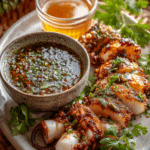
Thai Seafood Dipping Sauce
- Prep Time: 10 minutes
- Cook Time: 0 minutes
- Total Time: 10 minutes
- Yield: 1 cup (serves 4) 1x
- Category: Condiment
- Method: No-cook
- Cuisine: Thai
- Diet: Gluten Free
Description
A bold and flavorful Thai Seafood Dipping Sauce made with garlic, chili, lime, palm sugar, fish sauce, and roasted peanuts. This traditional Thai condiment, known as Nam Jim Seafood, perfectly balances spicy, sour, sweet, and salty flavors and pairs beautifully with shrimp, crab, squid, and grilled fish.
Ingredients
- 2 cloves garlic, peeled
- 4 red chilies, to taste
- 1/4 cup roasted peanuts
- 2 1/2 tablespoons palm sugar
- 2 tablespoons fish sauce
- Juice of 1/2 lime
Instructions
- Pound the garlic and chilies with a mortar and pestle until a fine paste forms.
- Add the roasted peanuts and continue pounding until they are crushed and mixed in.
- Add the palm sugar and fish sauce, mixing until the mixture becomes sauce-like in texture.
- Stir in the fresh lime juice and combine all the flavors well.
- Serve immediately with seafood and enjoy.
- Food Processor Method: Add garlic, chilies, roasted peanuts, palm sugar, and fish sauce into a food processor. Pulse until the mixture becomes a slightly textured sauce, not completely smooth. Stir in lime juice before serving.
Notes
- Use fresh lime juice instead of bottled for the best flavor.
- Adjust chili quantity based on your heat preference.
- Unsalted roasted peanuts work best for balance.
- Store leftover sauce in a sealed glass jar in the fridge for up to 3 days.
- For a milder version, remove chili seeds or add more palm sugar.
Nutrition
- Serving Size: 1 tablespoon
- Calories: 28
- Sugar: 2g
- Sodium: 120mg
- Fat: 2g
- Saturated Fat: 0.4g
- Unsaturated Fat: 1.3g
- Trans Fat: 0g
- Carbohydrates: 3g
- Fiber: 0.5g
- Protein: 1g
- Cholesterol: 0mg
Keywords: Thai Seafood Dipping Sauce, Nam Jim Seafood Sauce, Thai seafood sauce green, authentic Thai seafood dipping sauce, Thai seafood sauce bottle, Thai seafood dipping sauce recipe, Thai green seafood sauce recipe

